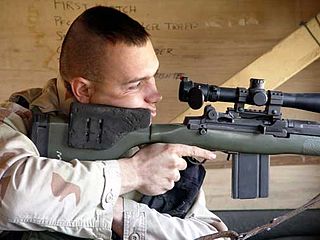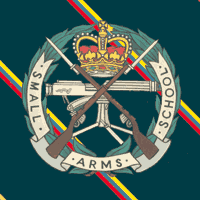Related Research Articles

The SA80 is a British family of 5.56×45mm NATO service weapons used by the British Army. The L85 Rifle variant has been the standard issue service rifle of the British Armed Forces since 1987, replacing the L1A1 Self-Loading Rifle. The prototypes were created in 1976, with production of the A1 variant starting in 1985 and ending in 1994. The A2 variant came to be as the result of a significant upgrade in the early 2000s by Heckler & Koch and remains in service as of 2024. The A3 variant was first issued in 2018 with several new improvements.

The Lee–Enfield is a bolt-action, magazine-fed repeating rifle that served as the main firearm of the military forces of the British Empire and Commonwealth during the first half of the 20th century, and was the standard service rifle of the British Armed Forces from its official adoption in 1895 until 1957.

The Canadian Army is the command responsible for the operational readiness of the conventional ground forces of the Canadian Armed Forces. It maintains regular forces units at bases across Canada, and is also responsible for the Army Reserve, the largest component of the Primary Reserve. The Army is headed by the Commander of the Canadian Army and Chief of the Army Staff, who is subordinate to the Chief of the Defence Staff. The Army is also supported by 3,000 civilian employees from the public service.

The Irish Army is the land component of the Defence Forces of Ireland. The Irish Army has an active establishment of 7,520, and a reserve establishment of 3,869. Like other components of the Defence Forces, the Irish Army has struggled to maintain strength and as of April 2023 has only 6,322 active personnel, and 1,382 reserve personnel. The Irish Army is organised into two brigades.

The Carl Gustaf 8.4 cm recoilless rifle is a Swedish-developed 84 mm (3.3 in) caliber shoulder-fired recoilless rifle, initially developed by the Royal Swedish Army Materiel Administration during the second half of the 1940s as a crew-served man-portable infantry support gun for close-range multi-role anti-armour, anti-personnel, battlefield illumination, smoke screening and marking fire, which has seen great export success around the globe and continues to be a popular multi-purpose support weapon in use by many nations. The Carl Gustaf 84 mm recoilless rifle is a lightweight, low-cost weapon that uses a wide range of ammunition, which makes it extremely flexible and suitable for a wide variety of roles.

A designated marksman (DM), squad advanced marksman (AD) or squad designated marksman (SDM) is a military marksman role in an infantry squad. The term sniper was used in Soviet doctrine although the soldiers using the Dragunov SVD were the first to use a specifically designed designated marksman rifle.

A section is a military sub-subunit. It usually consists of between 6 and 20 personnel. NATO and U.S. doctrine define a section as an organization "larger than a squad, but smaller than a platoon." As such, two or more sections usually make up an army platoon or an air force flight.

A marksman is a person who is skilled in precision shooting. In modern military usage this typically refers to the use of projectile weapons such as an accurized scoped long gun such as designated marksman rifle to shoot at high-value targets at longer-than-usual ranges.

In the United States (U.S.), a marksmanship badge is a U.S. military badge or a civilian badge which is awarded to personnel upon successful completion of a weapons qualification course or high achievement in an official marksmanship competition. The U.S. Army and the U.S. Marine Corps are the only military services that award marksmanship qualification badges. However, marksmanship medals and/or marksmanship ribbons are awarded by the U.S. Navy, U.S. Coast Guard, and U.S. Air Force for weapons qualifications. For non-military personnel, different U.S. law enforcement organizations and the National Rifle Association (NRA) award marksmanship qualification badges to those involved in law enforcement. Additionally, the Civilian Marksmanship Program (CMP) and the NRA award marksmanship qualification badges to U.S. civilians. Most of these organizations and the U.S. National Guard award marksmanship competition badges to the people they support who succeed in official competitions.

The origins of the modern British military rifle are within its predecessor the Brown Bess musket. While a musket was largely inaccurate over 100 yards (91 m), due to a lack of rifling and a generous tolerance to allow for muzzle-loading, it was cheap to produce and could be loaded quickly. The use of volley or mass firing by troops meant that the rate of fire took precedence over accuracy.

The Small Arms School Corps (SASC) is a small corps of the British Army, established in 1853 by Lord Hardinge. Its personnel provide advice and instruction to infantry weapon trainers throughout the army, in order to maintain proficiency in the use of small arms and support weapons, and in range management.

The Ukrainian Ground Forces, also referred to as the Ukrainian army, are the land forces of Ukraine and one of the eight branches of the Armed Forces of Ukraine. They were formed from Ukrainian units of the Soviet Army after Ukrainian independence, and trace their ancestry to the 1917–22 army of the Ukrainian People's Republic.
List of abbreviations, acronyms and initials related to military subjects such as modern armour, artillery, infantry, and weapons, along with their definitions.

The L1A1 Self-Loading Rifle (SLR), also known by the initial Canadian designation C1, or in the U.S. as the "inch pattern" FAL, is a British version of the Belgian FN FAL battle rifle. The L1A1 was produced under licence and adopted by the armed forces of the United Kingdom, Australia, Canada, India, Jamaica, Malaysia, New Zealand, Rhodesia and Singapore.
The Army Rifle Association (ARA) is the British army's shooting advisory and competition organising body. It is a registered charity independent of the chain of command.

The Canadian Armed Forces Small Arms Concentration (CAFSAC) and the Canadian Army Skill At Arms Meeting (CASAM) is a series of shooting matches conducted annually by the Canadian Forces at the Connaught Ranges and Primary Training Centre, located near Shirley's Bay in Ottawa, Ontario. The matches were preceded by the Dominion of Canada Rifle Association (DCRA) National Service Arms Competition, also conducted annually at Connaught Ranges, and were the latest iteration of a series of Canadian shooting competitions dating back to 1869 until 2019.

Ordnance Factory Tiruchirappalli (OFT), also called Ordnance Factory Trichy, is a small arms factory operated by Advanced Weapons and Equipment India Limited based in Tiruchirappalli, Tamil Nadu, which was previously part of Ordnance Factory Board of the Ministry of Defence, Government of India. The company is headed only by an IOFS officer called General Manager (ex officio Additional Secretary to Government of India) who is the chief executive officer, responsible for the overall management of the company.
References
- Infantry Training Volume IV Ranges Pamphlet No. 20 Competition Shooting 1988
- ↑ Pam 20 p 1-1
- ↑ Pam 20 p 1-1
- 1 2 "Sharp shot Cook wins Army shooting competition". MoD. 17 July 2009. Archived from the original on 9 April 2010. Retrieved 2016-10-01– via nationalarchives.gov.uk.
- ↑ Roger So Far: The First 100 Years of the Royal Corps of Signals. The History Press. 2020. p. 255. ISBN 978-0750995412.